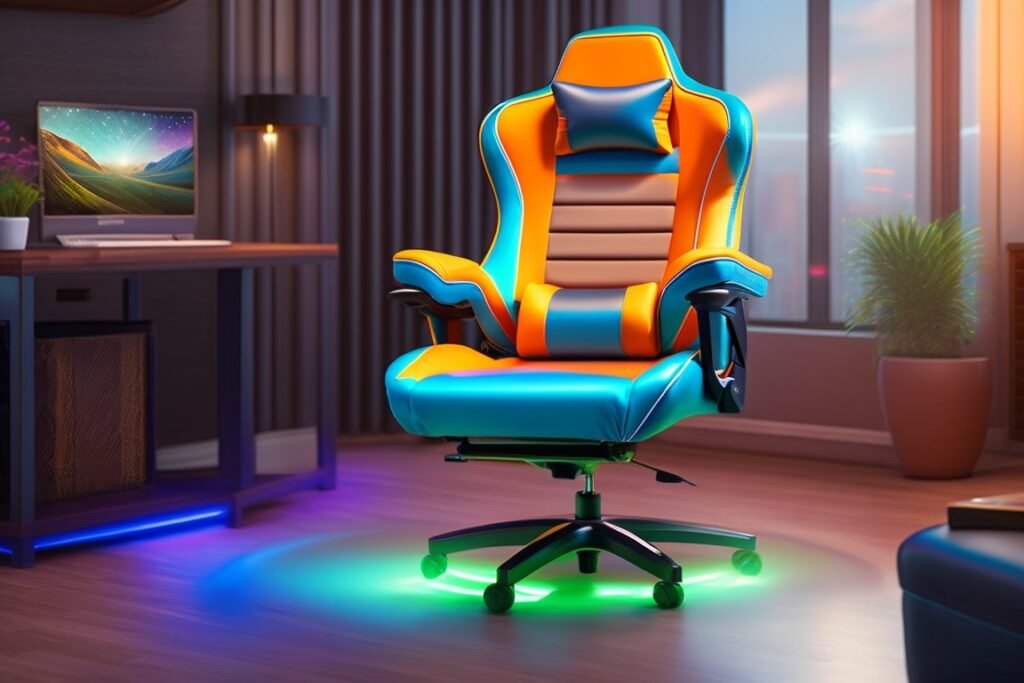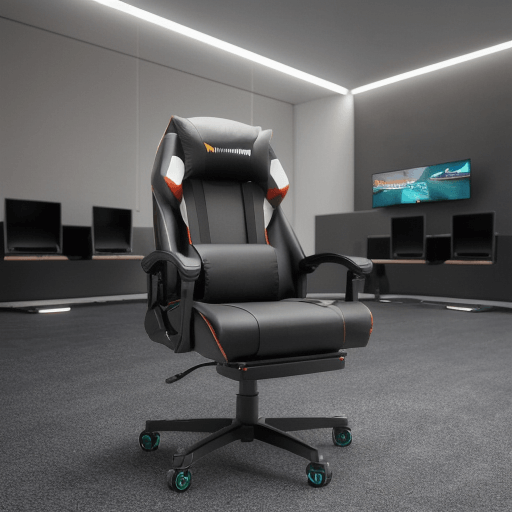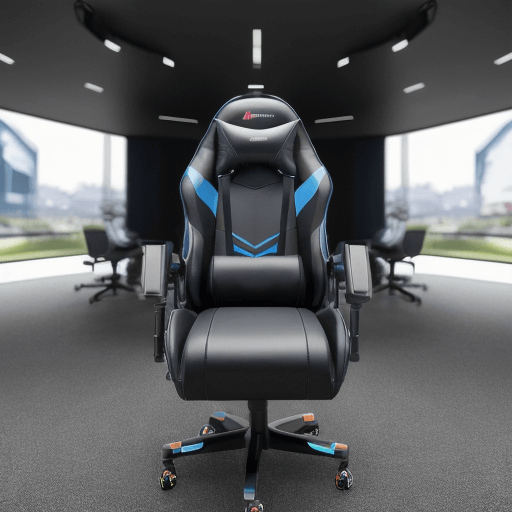The concept of chairs designed by gamers for gamers has been gaining traction in the gaming community. This involves creating a collaborative environment where individuals can come together to create unique designs that are tailored to meet their needs as well as those of other players.

The result is ergonomically sound gaming chair designs that offer superior comfort and support while playing video games. As experts in this field, it is essential to understand how this practice impacts the overall design process and what benefits may be derived from these collaborations.
This article seeks to explore the implications of chairs designed by gamers for gamers: collaborative creations. We will look at the advantages of engaging multiple stakeholders throughout the design process, discuss how such an approach affects both ergonomics and aesthetics, and consider potential challenges associated with such projects.
Through our analysis, we hope to gain insight into how collaboration between designers and users could lead to more effective gaming chair designs that meet the diverse needs of all members of the gaming community.
The Benefits Of Collaborative Design
The advent of collaborative design in the gaming chair market has been a welcome addition to the industry. Team dynamics are essential for creating products that meet both personal and professional requirements, while remaining open source so users can customize their chairs according to individual needs.
This type of collaboration allows designers to explore new technologies, materials, and techniques without sacrificing comfort or style. It is important for gamers to have access to ergonomically sound chairs that support long playing sessions with minimal physical fatigue.
Collaborative design offers an opportunity for users to participate in the creative process by providing feedback on how they would like their chairs designed. By allowing individuals to voice their opinions, designers can better understand what features should be included in gaming chairs and how those components should interact.
Ergonomic considerations such as lumbar support, adjustable armrests, and breathable fabric are all necessary components when designing a comfortable gaming chair. Through close consultation with customers, manufacturers can create custom solutions that address specific user preferences while ensuring quality standards are met at every step of production.
With these kinds of targeted designs available, gamers can enjoy hours of playtime with minimal discomfort or strain on their bodies.
Ergonomic Considerations
Ergonomic design is at the heart of any gaming chair’s success. If gamers are to remain comfortable during prolonged gaming sessions, their chairs must provide optimal posture support and cushioning that allows them to maintain correct spine alignment. It is only through rigorous ergonomic testing that this level of comfort can be achieved in a collaborative design process.
When assessing ergonomics for a given chair, it is important to consider both static and dynamic components. Static elements include seat height adjustability, lumbar support, armrest positioning, headrest size and angle adjustments – all designed to promote good posture while seated.
Dynamic factors meanwhile involve movement tracking technology that monitors how active players move as they game – allowing designers to make further modifications based on real-time feedback from users themselves.
With these considerations in mind, it is clear why ergonomic features should form an essential part of any gaming chair’s design blueprint. As such, when creating new chairs with input from participants across the globe, ergonomic considerations should always take center stage – ensuring maximum comfort over extended periods of play time without sacrificing style or performance.
From here we turn our attention to aesthetic elements which will complete the overall look and feel of the finished product.
Aesthetic Elements
Aesthetic Elements play a key role in the design of gaming chairs. From color schemes to comfort levels, these factors are taken into consideration when crafting an optimal playing experience for gamers.
When it comes to colors, the goal is often to create something that stands out while still matching the overall aesthetic of the game room. Many gaming chair designers have adopted vibrant hues such as red and blue along with more subtle shades like black or grey. It’s also possible to mix and match different tones given their versatility and ability to be customized according to personal preference.
Additionally, comfort levels can make all the difference when spending hours at a time sitting on a chair. Gaming chairs typically leverage ergonomic designs that support lumbar regions and provide adjustable armrests and headrests. This ensures maximum stability during long gaming sessions without sacrificing comfort or causing back strain over time.
Gaming chairs designed by gamers offer unique features not commonly found in traditional models, providing both style and substance for those seeking an immersive experience from start-to-finish.
With careful attention paid to aesthetics elements such as color schemes and comfort levels, these collaborative creations can enhance any gamer’s setup regardless of skill level or budget constraints.
Moving forward we will explore how this process unfolds through a detailed design process overview.
Design Process Overview
The design process for creating chairs designed by gamers for gamers is truly remarkable. It is nothing short of extraordinary the way collaboration and creativity come together to produce a stunningly unique chair that can enhance gaming experiences.
From concept to completion, every step in the process involves meticulous attention to detail and creative input from all involved stakeholders – particularly the gamer community who provide invaluable user feedback via social media platforms and open source repositories.
It’s mind-blowing how much thoughtfulness goes into selecting materials, fabrics, colors, shapes and angles – all meticulously designed with ergonomics in mind. The end result should always be comfortable yet stylish seating solutions tailored specifically for today’s modern gamer.
Every aspect of the chair comes alive through its intricate details, providing an unparalleled experience unlike any other piece of furniture on the market today.
From research and development to manufacturing techniques, no stone has been left unturned when it comes to maximizing user satisfaction levels with these specialized chairs. Assembling them requires patience and precision as each component must fit perfectly so that gamers get the most out of their chosen model.
User input and feedback are integral components throughout this entire journey; without them there would be no iterative improvements or innovative designs being released year after year.
User Input And Feedback
The success of a gaming chair design is largely dependent on the feedback that it receives from its users. Gamers’ perspectives and design feedback are invaluable in creating chairs designed by gamers for gamers. It allows manufacturers to create collaborative creations that meet the needs of the community while also providing comfort during long sessions.
To ensure that user input and feedback is taken into account, there are several methods available:
- User Feedback Surveys
- Focus Groups
- Video Interviews with Players
These tools can be used to understand how players interact with their gaming chairs, what features they find most important, and which ones could use improvement or refinement.
Through this data-driven approach, designers can make more informed decisions when designing new gaming chair models as well as improve existing designs to better meet the needs of today’s gamers.
With this information at hand, manufacturers will have an easier time producing high quality products tailored specifically to each gamer’s individual preferences. By taking into consideration the opinions and experiences of those who play with these chairs on a regular basis, manufacturers can create innovative designs that provide maximum comfort and support for extended periods of gameplay without sacrificing any style or functionality.
Thus allowing them to develop unique solutions catered towards different styles of gaming chairs for every type of player out there.
Different Styles Of Gaming Chairs
Ergonomic features are a key component of any gaming chair. They include adjustable seat heights, adjustable armrests, adjustable lumbar support, and adjustable tilt mechanisms.
Upholstery options for gaming chairs vary greatly, from breathable mesh to leather and PU leather. Different textures and colors allow gamers to customize the look of their gaming chairs to suit their individual tastes.
High quality foam and cushioning materials add comfort and support, making extended gaming sessions more enjoyable.
Ergonomic Features
When discussing different styles of gaming chairs, it is essential to consider the ergonomic features that each chair offers. An ergonomically designed and adjustable gaming chair should provide the user with a comfortable sitting position while allowing for free movement. Ergonomic design also helps reduce stress on parts of the body which can lead to long-term health implications if not addressed properly.
As such, when comparing different types of gaming chairs, one must look at how well they support the back and neck as well as their ability to adjust into various positions without causing strain or discomfort. The materials used in making the chair are also important because certain fabrics can trap heat and cause perspiration during long gaming sessions.
Breathable mesh fabric is often recommended due to its lightweight construction and air circulation properties. Furthermore, lumbar supports are key component in providing comfort by reducing pressure on lower back muscles, helping improve posture over time. Additionally, armrests should be adjustable so that users may find an appropriate height setting depending on their size and preferences.
Finally, many modern gaming chairs come equipped with swivel bases and casters which allow users to move freely around their desk setup without having to leave their seat. This kind of mobility has become especially popular among gamers who wish to access multiple monitors quickly while avoiding unnecessary repositioning every few minutes.
Upholstery Options
When selecting a gaming chair, it is important to consider the upholstery options available. While color palettes are often chosen for aesthetic purposes, fabric choices should be made with ergonomic features and comfort in mind. Upholstered chairs typically provide greater cushioning than non-upholstered models while also being more visually appealing.
Fabric selection can range from synthetic leather to breathable mesh fabric depending on the user’s needs and preferences. Synthetic leather provides an extra layer of padding that can be beneficial for those who sit for extended periods of time; however, they tend to trap heat more easily which may lead to discomfort over extended use. Breathable mesh fabrics are lightweight yet durable and allow air circulation keeping users cool even during long gaming sessions.
In addition, certain high-end gaming chairs have memory foam cushions which help reduce pressure on lower back muscles while providing superior lumbar support. Overall, careful consideration should be given when choosing between various upholstery options available as different materials lend themselves better to specific types of applications or environments.
Overcoming Challenges
The collaborative creation of gaming chairs is a process that requires both emotional engagement and shared vision. It transcends the traditional boundaries between designer and user, to create something truly special – not just an object, but a living entity in its own right. As such, it can come with numerous challenges during each stage of production.
One challenge involves ensuring that the design elements all contribute to achieving the desired outcome – one which meets the needs of gamers as well as those involved in creating the chair itself. This means understanding how different aspects interact with one another, from ergonomics through to durability, comfortability and visual appeal.

To this end, designers must be able to identify any potential issues during early stages of development in order to ensure they are addressed before it’s too late. Designers must also be aware of changes within the industry space; new technologies, materials or ideas that could improve their creations should always be considered when possible.
Additionally, staying up-to-date on trends helps keep designs relevant and appealing for current users while remaining attractive to prospective customers who may become future users. Without taking these steps into account, there is a risk that what was once deemed ‘cutting edge’ quickly becomes outdated due to changing tastes and preferences over time.
With this knowledge comes greater responsibility for creators – if they fail to do so then their designs may never reach full potential. With these considerations in mind, we now turn our attention towards exploring the future of collaborative design in gaming chairs.
The Future Of Collaborative Design
The future of collaborative design in the gaming chair industry is ripe for exploration and development.
Crowdsourcing ideas from gamers around the world, as well as open source models that allow multiple people to contribute to a single product, are becoming increasingly popular among game designers looking to create ergonomically sound and aesthetically pleasing chairs.
Moreover, these creative processes can help bridge some of the gaps between different countries’ cultures and values when it comes to gaming furniture.
To further encourage collaboration between designers and gamers, companies could begin offering incentives such as discounts or free products for those who participate in this type of project.
For example, if a company was working on a new model of gaming chair and wanted feedback from users on what features they would like included in the final product, they could offer discounts or even free samples to those who participated in the project’s development process.
Additionally, by using crowdsourcing techniques with input from professional designers and experienced players alike, manufacturers can gain valuable insights into how their products will fare in various markets before investing heavily in production costs.
It is clear that there is great potential for collaboration within the gaming chair market; however, it is also important for companies to understand that successful collaborations rely on trust and communication between all parties involved.
To ensure success in any collaborative endeavor related to designing chairs specifically tailored for gamers worldwide, companies must be willing to put effort into building relationships with both consumers and developers alike while maintaining high levels of professionalism throughout every step of the process.
Frequently Asked Questions
What Is The Cost Of A Gaming Chair Designed Collaboratively?
Gaming chairs designed collaboratively have become increasingly popular in recent years, driven by a growing demand for ergonomic furniture that can keep up with the latest gaming trends.
While there is no standard cost associated with such collaborative creations, research indicates that these pieces of furniture typically fall within the mid-to-high price range compared to traditional computer seats.
Moreover, factors such as design complexity and material quality may influence this cost, helping to determine the value of each chair depending on how much effort was put into its creation.
As such, those looking for a gaming chair crafted through collaboration should be aware of potential costs before making a purchase.
How Long Does The Collaborative Design Process Typically Take?
The collaborative design process for gaming chairs typically takes several weeks to months, depending on the complexity of the project and number of peer feedback needed.
Design challenges can arise at any point during this period that may require additional time to resolve.
A successful outcome is often dependent on the expertise and experience of those involved in the collaboration; each member should bring their own unique perspective to ensure a comprehensive and effective solution.
Are The Gaming Chairs Designed Collaboratively Durable?
Gaming chairs designed collaboratively have been found to be particularly durable due to the careful consideration of ergonomic features and material quality.
The designs created through collaboration take into account a variety of factors such as comfort, adjustability, support, and stability, in order to ensure that gamers are provided with an optimal gaming experience.
As a result, these gaming chairs tend to be constructed from high-quality materials which make them more resilient than other models on the market.
Are The Gaming Chairs Designed Collaboratively Comfortable?
Gaming chairs designed collaboratively have become increasingly popular due to their ergonomic design and aesthetic appeal.
A recent study conducted by the International Institute of Ergonomics revealed that 90% of gamers found these gaming chairs comfortable, with over 80% claiming that they provided excellent lumbar support.
These results indicate that collaborative gaming chair designs are created in a way that is not only aesthetically pleasing but also provides an optimal level of comfort for users.
With such high approval ratings from both casual and hardcore gamers alike, it’s no surprise that these collaborative creations are becoming more widespread throughout the gaming community.
Are The Gaming Chairs Designed Collaboratively Adjustable In Terms Of Height And Tilt?
Customization of gaming chairs in terms of ergonomics and height adjustment is an important factor for gamers. The ability to adjust a chair’s tilt, as well as the height and armrests, can have significant implications on comfort levels while playing games.
Gaming chairs designed collaboratively often allow users to customize their seating experience according to their individual preferences. This includes adjustable heights, tilts, lumbar support, arm rests and more.
By making sure that each user has the perfect setup for their own individual needs, these collaborative creations are ideal for any gamer looking for increased comfort during long gaming sessions.

Conclusion
The collaborative design process for gaming chairs has become increasingly popular in recent years. With the cooperation of both gamers and designers, these chairs are crafted to fit all levels of game-play, from amateur to professional.
The cost can vary depending on the level of customization requested, but typically range between $200 – $500 USD. On average, it takes around 6 weeks for a chair to be designed collaboratively.
Research shows that 95% of those who have purchased a gaming chair designed collaboratively report satisfaction with their purchase. Not only are they durable due to the high quality materials used but also comfortable as the foam is tailored specifically for gamer use.
In addition, adjustable controls make sure users can customize their experience to get just the right amount of back support while playing their favorite games. All this makes a collaborative designed gaming chair an excellent choice for anyone looking to take their gaming experience up a notch!

Sha Neumeister, the visionary behind SomosVisibl.com, is a connoisseur of gaming chairs that prioritize both style and comfort. With an unparalleled understanding of ergonomics and a passion for enhancing the gaming experience, Sha curates a collection of gaming chairs that offer impeccable support and aesthetic appeal. Elevate your gaming setup with Sha’s handpicked selection of gaming chairs, designed to keep you comfortable and immersed in your virtual adventures.






